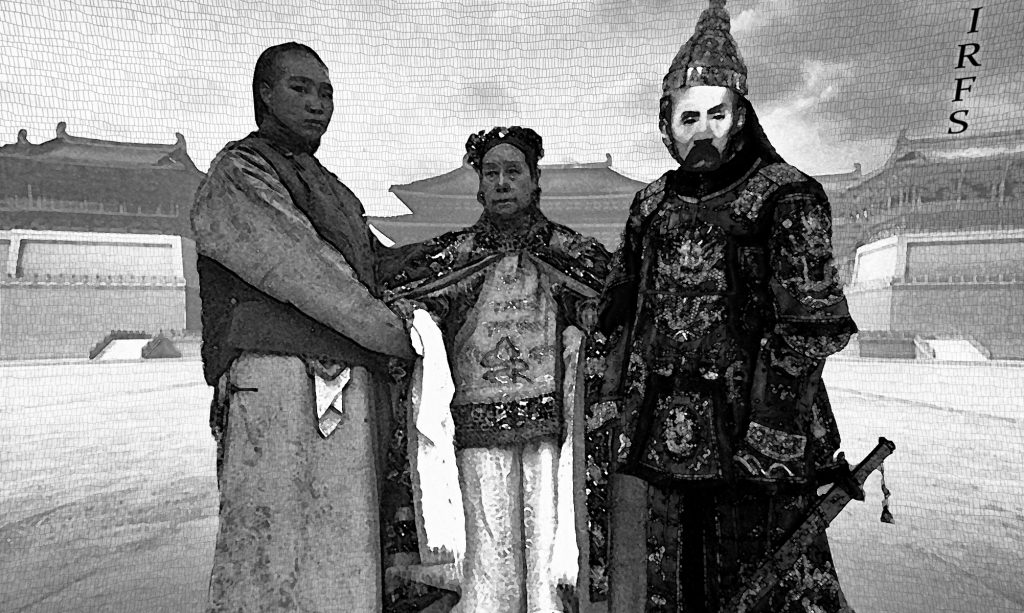≡Imperial Renaissance Fighting Systems/IRFS≡ encompasses ancient martial science and psychology, salvaged from the ashes, and restructured for the modern man. The foundations are drawn from Beijing Renaissance arts of Yin Style Baguazhang, Cheng Baguazhang, Shaolin, Bajiquan, and Feudal Chen Tai Chi Chuan. Feudal martial artistry, in its purist form, descend directly from elite military professionals during unforgiving eras. Most city people today require a different way of life than the ancients in regards to the context of martial application and studies. By the 20th century, Internal Martial Arts were reimagined by reformers and teachers as ways to preserve Chinese culture, or to strengthen the Chinese nation against foreign oppression- and with merit gave life to many fantastic, emotional, and unrealistic depictions of ancient Kungfu masters. Popular Baguazhang instruction today is inspired by the popular 1920s novel ‘Tong Lin Chuan’, which presents the founder of Baguazhang’s context of fighting in a Chinese Comission for Physical Culture and Sports kind of way. Historical research by numerous Chinese scholars reveals- there is no evidence the ancient masters earned their reputation by the context of training, in today’s kungfu culture. Feudal Yin and Cheng Style Baguazhang has roots in the Imperial Court during the mid-1800s at Chongwenmen, Beijing, where Dong Haichuan served as Imperial tax collector and Bodyguard for Prince Su (Shan Hao). The real person named Dong Haichuan (1797 – 1882) was born in the Jiaqing period of Qing Dynasty, formerly known as Dong Mingkui, and was born in Zhujiawu Village, Wen’an County, Hebei Province. The Dong family lived in Hongdong County in Shanxi Province. The ancestors of Dong Haichuan were the generals of the Yuan Dynasty. They served as the deputy marshal of the general of Long Huwei. Dong’s ancestors moved to the city of Hebei in the early years of the Ming Dynasty. The descendants of their descendants were military commanders for five consecutive generations. According to Wen’an Wenshi data and Xiongxian County records, many people in the Dong Haichuan family are military commanders and Shaolin professionals. Dong Haichuan synthesized Baguazhang, a sophisticated martial art, adapted to each individual by his own experience while retaining the essential principals and structure. The Senior Disciple of Dong Haichuan, Yin Fu, adapted principals of the art to his own martial background (Qing Military/Intelligence), developing Yin Style Baguazhang. The Yin style of Baguazhang popularized the “OX-Tongue” palm- however, the modern context of application is primarily influenced by equal ratios of the Peking Opera tradition, ‘Tong Lin Chuan’ novel, and combat sports borrowed from western cultures. The separation of Yin and Cheng styles on a palm shape is a misunderstanding.Historical evidence reveals Yin Fu utilized “Tiger Claw/ Dragon shape” as well, and the “Ox” palm is a mislabeling of the “Willow-leaf” palm, attributed to the short spear and willow leaf sabers of Imperial Guards in 1800s. Yin Fu’s is renown for tactics and framework that is not encumbered by aesthetic, ritual, or sporting aspects- a standard in martial training requirements of Imperial Officers & cavalry. The Yin Style of Bagua is an integrated part of modern martial arts branching from “The Fairbairn Method” of William E. Fairbairn. One of William E. Fairbairn’s students was Ian Fleming who went on to write the James Bond series of books. Yin Style Baguazhang contains Shaolin empty-hand and armed strategy of various military divisions- modern firearms, pudao, spear, military saber, zhanmadao, and clandestine weapons. Yin Fu is a First Rank Imperial Guardsman of Emperor Guang Xu and the Empress Dowager. In the early 20th century, his disciple, Cui Zhendong /Retainers of the Imperial Court, instructed Baguazhang to William E. Fairbairn. Fairbairn made dedication in his book All In Fighting (1942) to Cui calling him a man of “terrifying prowess.” Cheng Ting Hua is the other top student of Dong Haichuan- a candidate for the royal bodyguards of Empress Cixi. The Cheng style of Baguazhang popularized the Dragon Claw Palm, characterized by fluid (weaving/interlinking) body (serpent/dragon-like) movements with complex coiling and spiraling. The style is more dynamic and smooth externally, with intricate footwork patterns, wrestling/ restraint methods. Researchers in China have now revealed, the “mud-stepping” footwork attributed to Cheng Ting Hua’s style, is developed by later generations post 1920s- decades after Cheng Ting Hua’s death. The feudal Cheng Bagua system is characterized by close-in fighting and takedowns, with the cudgel and glaive as the first-line of defense.


